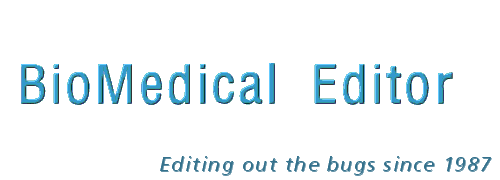"Hedging" in Scientific Writing
One meaning of hedge is a protective boundary of dense shrubbery. In writing,
hedging is the use of cautious language to make noncommittal or vague statements, that is:
To evade the risk of commitment, especially by leaving open a
way of retreat1
Authors allow for this opening in their statements and conclusions for several reasons: to report the limits
of their findings, to protect themselves from the risk of error, and to convey modesty.
Cautious language has a legitimate and important place in scientific writing, although authors need to guard
against using it to excess. Qualifiers (modifiers), the passive voice, and apologetic quotation
marks are three commonly used hedging techniques.
1. Word choice: Unnecessary qualifiers
Qualifiers are words that modify or limit the meaning of other words. Qualifiers may be added justifiably to
scientific writing to limit the scope of a statement.2
Hundreds of words and phrases can be used alone or in combination to express approximation, probability, or
doubt. Common examples include the following:
Adjectives: apparent, certain, consistent with, few, many, most, possible, presumed, probable,
putative, several, some, supposed
Adverbs: about, apparently, arguably, fairly, in general, largely, likely, more or less, mostly, often,
perhaps, possibly, presumably, probably, quite, rather, somewhat, unlikely, usually
Nouns: appearance, indication, inference, likelihood, possibility, probability, suggestion, tendency, to
my knowledge
Verbs: aim, appear, assume, can, could, estimate, indicate, infer, intend, may, might, presume, propose,
seem, seen as, should, speculate, suggest, suppose, tend
When used in moderation, qualifiers temper a researcher's certainty about a method or observation.
However, double, triple, and quadruple synonyms are unnecessary (e.g., may be possible; seems to
suggest, rather likely to indicate, may be seen as rather likely). Similarly, successive hedge
words pile up within a sentence, depleting it of its strength and meaning:
A possible cause is likely the apparent tendency of a certain
number of patients with diabetes to develop indications of retinopathy.
This sentence can be revised to minimize the number of qualifiers:
A possible cause is the tendency of patients with diabetes to develop retinopathy.
To strengthen your argument and increase clarity, limit the number of qualifiers in each sentence to only those
necessary for accuracy—the remaining qualifiers will then do their job well.3
2. Point of view: Unnecessary passive voice
Sentences written in the passive voice focus on the receiver or product of the action. They include a form
of to be and the past participle of a verb. A by phrase to name the performer follows or is implied
(e.g., The results were reported by Thomas et al.).
A noncommittal form of the passive voice occurs when authors fail to name themselves (with the personal pronouns
I, we) or other researchers as the performers. This type of passive often begins with the word It
(e.g., It was apparent...; It has been noted...; It was decided...; It is known to be...).
In these sentences, the person performing the action remains unnamed: Who reported the
results? To whom was it apparent? The reader is forced to guess who holds the view.
Passive-voice sentences have their place when the performer is less important than the action. For example, an
author may decide to write in the passive voice in the Methods section (see
"The Value of the Passive Voice").
However, passive constructions allow authors to hedge about the identity of the performer:
It was concluded that sleep deprivation has three effects on
cognitive performance.
In this sentence, the passive voice protects the authors from the risk of uncertainty. However, this device
increases ambiguity (Who concluded?). The reader may find it especially difficult to sort out who
did what when authors use the passive voice to describe their own work and that done by other researchers in the same
paragraph.
Unless you have good reason to write in the passive voice, use the
active voice to identify the performer (e.g.,
We concluded that...). Doing so will improve the clarity and readability of your writing.
3. Punctuation: Unnecessary quotation marks
Some authors like to add quotation marks to emphasize expressions that are being used for irony or in a
nonstandard or special sense:
Many patent "medicines" in the 1800s contained little more
than alcohol and water.
Also called apologetic quotation marks or scare quotes, these marks are applied to tell the
reader that an expression is not the author's and is not being used in the usual way.
The author hedges by adding quotation marks rather than trusting readers to draw their own conclusions or to
recognize the irony or special use (e.g., see the title at the top of this
page).
To avoid irritating your readers, use apologetic quotation marks sparingly or not at all. Many style guides
consider them unnecessary.4-6
Summary
Devices for hedging—in writing, not gardening—include qualifiers, passive voice, and quotation marks.
These devices are useful when applied judiciously. To reduce ambiguity and improve readability:
- Eliminate unnecessary qualifiers in each sentence.
- Use the active voice as necessary to name the performer.
- Apply apologetic quotation marks sparingly, if at all.
Sources
- Merriam-Webster's Collegiate Dictionary. 11th ed. Springfield, MA: Merriam-Webster, Inc.; 2007.
- Sternberg RJ. The Psychologist's Companion: A Guide to Scientific Writing for Students and
Researchers. 4th ed. New York, NY: Cambridge University Press; 2005.
- Matthews JR, Bowen JM, Matthews RW. Successful Scientific Writing: A Step-by-Step Guide for the
Biological and Medical Sciences. 2nd ed. Cambridge, England: Cambridge University Press; 2000.
- Iverson C, Christiansen S, Flanagin A, et al. AMA Manual of Style:
A Guide for Authors and Editors. 10th ed. New York, NY: Oxford University Press; 2007.
- American Psychological Association. Publication Manual of the American Psychological
Association. 6th ed. Washington, DC: American Psychological Association; 2009.
- The Chicago Manual of Style. 15th ed. Chicago, IL: The University of Chicago Press; 2003.
Questions or comments about this writing tip?
Contact me online and I'll be happy to
help.
For information on scientific and medical editing, please
visit Science Editing
Services.
